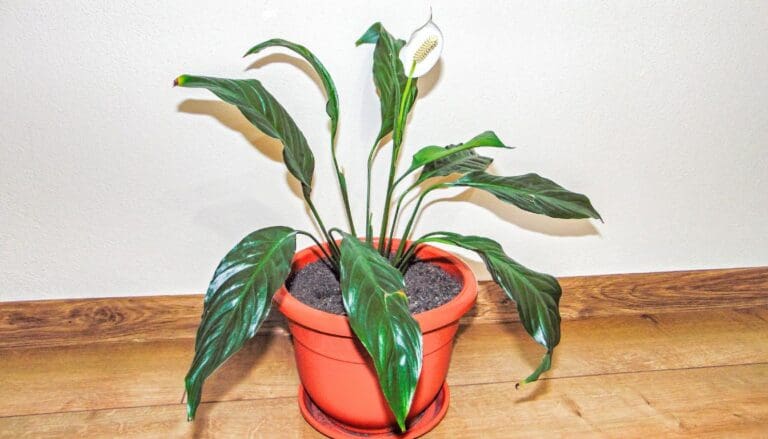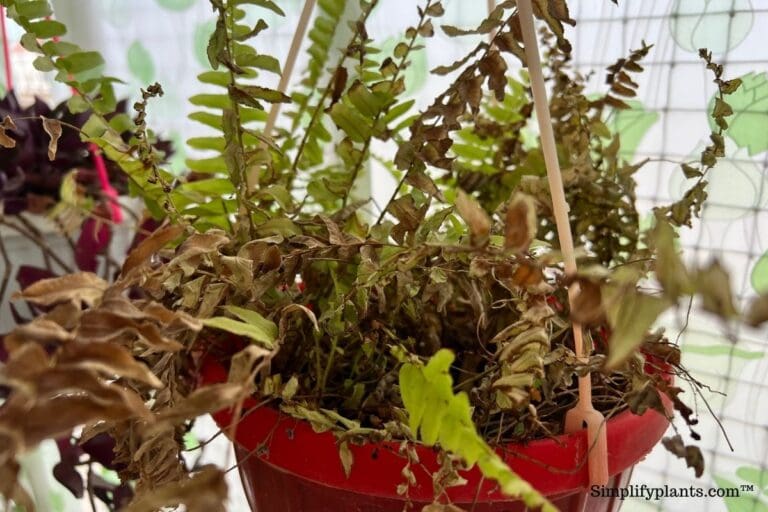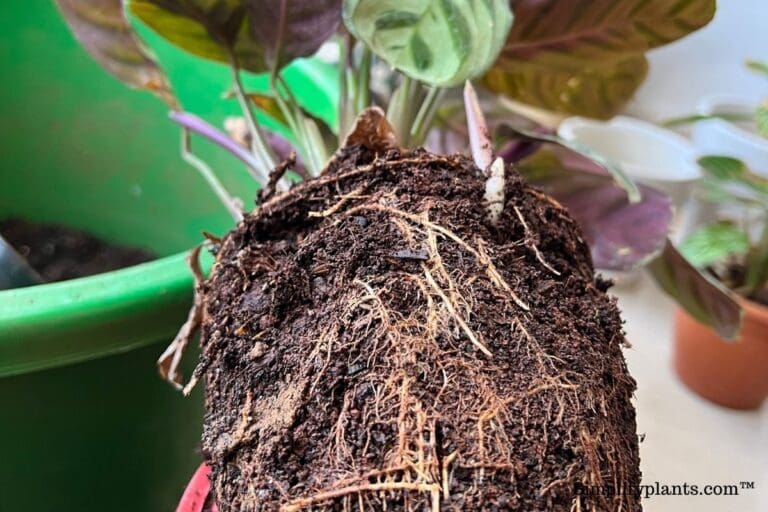Why Are My Croton Leaves Curling? (Possible Causes+Fix)
Crotons are houseplants native to Southeast Asia and the Pacific regions. Since they come from a humid tropical environment, it becomes difficult to care without the ideal conditions. They might show signs like curled leaves if their ideal conditions are absent.
But why are your croton leaves curling? How can we fix the same?
Underwatering is the primary cause of curly leaves in crotons. Crotons love moist soil, and lack of water will make the soil dry, causing the leaves to curl up. Other reasons for curling can be root rot, low humidity, stress, excessive heat, low light, and pest infestations.
This article will help you identify the reasons behind curly leaves in your croton. It will also provide you with the remedies to fix the problems. So, keep reading.

Please note: Simplify Plants is reader-supported. Some links in the post are affiliate links and I get a commission from purchases made through links in the post.
Why are my croton leaves curling?
Crotons typically have lush, colorful foliage.
But like any other plant, when their demands are not met, the leaves curl up.
One such problem can be underwatering, and there can be many other such reasons for curling.
If you don’t identify the cause on time, your Croton might even die.
If you provide proper care, your plant will recover and have new leaves again.
The possible reasons for curly leaves in Crotons are:
- Underwatering
- Overwatering
- Low humidity
- Lack of light
- Poor water quality
- Overfertilization
- Temperature fluctuations
- Pest infestation
Now, lets us discuss each point in detail.
Underwatering

If the leaves at the bottom of your croton plant start drying up or the corners of the leaves turn brown and crispy, understand that your plant is experiencing underwatering.
Crotons prefer moist soil but don’t like to sit in soggy soil.
They require watering once a week to remain healthy.
Keeping your Croton without water for long will make the soil dry.
Dry soil will fail to provide any nutrients or water to the plant.
The plant will get dehydrated, and due to insufficient nutrients, it will not get any energy to perform its daily activities.
The leaves will curl to retain the remaining moisture present in them.
How to fix underwatering?
To solve the underwatering problem, you should check the soil’s moisture level to understand if your Croton is thirsty.
You can check the moisture level by using a moisture meter.
You can also check it by inserting your fingers in the soil.
In general, if the top 1-inch layer of the soil is dry, water your crotons.
In summers, they will require water more frequently and about an inch per week.
So keep a proper check on the soil and maintain a proper watering routine.
You can frequently mist the plant, increasing the moisture level around it.
If you find that the soil has dried up, you need to find some methods to fix the soil.
One such way is by soaking the soil in water.
You can do this by filling a big container with water and letting the croton sit in water after taking it out of the pot.
When the dry soil becomes moist and porous, remove the plant and keep it in sunlight.
Don’t keep your Croton thirsty for too long again.
Also read: How Often To Water Croton Plant? (Watering Schedule+Watering Problems)
Overwatering

If the entire leaves of your croton start to curl downwards, it might be due to overwatering.
Yellow and droopy leaves can also be a sign of overwatering.
Crotons love moisture but watering them without checking the soil’s moisture level often leads to overwatering.
A pot with a poor drainage system can also cause overwatering issues.
Overwatering is more harmful than underwatering as it will keep the soil wet for extended periods, which will cause deadly diseases like root rot.
Root rot happens when the plant’s roots start to turn mushy and brown as a result of excess moisture in the soil.
It will further attract pests and diseases towards the plant.
In case of root rot, you need to repot and prune all the damaged parts of the Croton.
So, you should take immediate steps as soon as you find issues like root rot to save your crotons.
How to prevent overwatering?
To prevent overwatering, consider watering your crotons once a week.
Before watering, always check the moisture level of the soil.
Use a moisture meter that will make this work easy.
Water your Croton only when the top 1 inch of the soil feels dry during the growing season.
If the topsoil feels wet, avoid watering.
In winters, water the plant only when the top two inches of the soil feel dry.
Always plant crotons in pots with drainage holes.
To grow crotons, use a good-quality potting mix that retains enough moisture and drains excess water.
You can prepare a potting mix using perlite, peat moss, and loamy soil to improve soil drainage.
Avoid using soil with high clay content, as it holds water for an extended period that will cause overwatering issues.
Also read: How To Save Overwatered Croton Plant? (Signs, Problems & Solution)
Low humidity

Crotons are tropical houseplants that need warm temperatures and a higher humidity level to thrive.
They need a minimum of 40% humidity to remain healthy.
Low humidity levels will make the surrounding region dry, due to which the moisture level also falls.
In such a situation, if the plant opens its pores for transpiration, loses water, and gets dehydrated.
The leaf starts to curl as curling reduces the surface area and prevents early loss of water through transpiration.
Poor humidity and underwatering can both cause your plant to get dehydrated, so it’s essential to identify the actual cause of curling for their quick recovery.
How to maintain humidity for crotons?
Many ways to increase humidity for Crotons:
- Use a humidifier to increase humidity levels around your croton plant.
- You can mist the plant with a spray bottle every one or two days in the fall or winter months.
- Use a pebble tray to improve the humidity levels around crotons.
- You can group your Crotons with other humidity-loving houseplants so that they can add moisture to the surrounding through transpiration.
- You can add a mini greenhouse to hold moisture around the plant.
- You can also place your croton plant in areas with high humidity, such as a bathroom or indoor pool area.
Also read: Do Crotons Need Misting? (+Maintaining Ideal Temperature)
Lighting issues

Crotons have vibrant, colorful leaves that come in a wide range of pink, yellow, green, red, etc.
The leaves need lots of energy to maintain the colors they get from the sun.
Crotons will need full sun to remain healthy.
Low light will affect their photosynthesis process.
They won’t be able to perform photosynthesis without proper light.
Due to this, the leaves will curl when they do not get enough nutrition.
Also, the leaves of your Crotons will curl if you will expose them to direct sunlight for too long.
Direct rays from the sun will heat the plant, dry its leaves, and cause sunburn.
Excessive heat will drain the moisture out of the plant leading to several other problems.
Often the heat generated by appliances such as heaters, radiators, gas burners can severely affect your plants and cause curly, brown, and crispy leaves.
What is the ideal light for crotons?
Place your Crotons in an area where they will receive at least 6 hours of full sun every day.
The ideal spot for them will be an eastern, southern, or western window as these spots will provide the ideal bright sunlight.
Always place the plant one foot away from the window if the sunlight is too intense.
Put curtains to protect them from excessive direct sunlight.
You can keep your plant outdoors to give it enough sunlight in winters.
If the light is not enough, you can use grow light or fluorescent to fulfill their light requirements.
Also read: What Kind Of Light Does A Croton Need? (Croton Light Requirements )
Poor water quality

Another factor determining your plant’s health is the type of water you are using for watering them.
If the water quality is low or contains harmful substances like chlorine, sulfur, or fluorine, all these will affect your Croton and cause curly leaves.
You can sometimes use tap water to water crotons, but excessive use can damage their roots.
Tap water has lots of added minerals that will build up in the soil to burn their roots.
Also, the water should not be cold.
Coldwater will cause root shock, which may damage the roots permanently, cause curly leaves, and many other problems.
What kind of water is preferable for crotons?
Your croton will grow best when you use filtered or distilled water to water them.
If you have a filtration system, use filtered water as it is the safest watering option.
You can also use rainwater.
Always use room temperature water and don’t use warm or cold water.
Extreme cold or warm water can harm their roots.
Also read: How Often To Water Croton Plant? (Watering Schedule+Watering Problems)
Improper fertilization

Crotons need sufficient nutrition for their healthy growth, especially during the growing season.
Fertilization is vital as soil and water will not meet their nutritional needs.
Lack of nutrition will weaken the plant, and the leaves will curl at one point.
Also, if you frequently fertilize your Croton without checking the quantity, they might experience overfertilization.
The excess salts from the fertilizers will get deposited on the soil and will make the soil acidic, which can burn your croton’s roots.
Also, the salts will take the moisture out of the plant, causing the leaves to turn brown, crisp, and curly.
What are the best fertilizers for crotons?
Fertilize your Crotons every month during their growing season.
Choose fertilizers with NPK (Nitrogen, Phosphorus, potassium) to enhance their growth and health.
Fertilize them with a water-soluble fertilizer with an NPK ratio of 3-1-2.
Liquid fertilizer is the best option for crotons as it prevents overfertilization, and you can easily control the consistency of nutrients you want to provide them.
If the fertilizers have a higher level of nutrients, you can mix water to balance the nutrition level.
Also read: What Temperature Can Croton Tolerate? (+Ideal Temperature Range)
Temperature fluctuations

Crotons come from warm and humid climates, and they need temperatures similar to their native region to thrive.
The temperatures that crotons prefer are between 65 to 80°F.
A sudden temperature change will stress your croton and cause their leaves to curl upwards.
If you expose the Croton to direct sunlight for too long, the plant will evaporate quickly, due to which the leaves will curl to prevent early moisture loss.
All these will make your plant dry.
During winters, when the temperature level drops and when crotons are exposed to cold temperatures, they will get stressed and react by curling their leaves.
How will you maintain the ideal temperature for crotons?
To keep your crotons happy, maintain temperatures around 65-95°F.
In summers, if your plants are affected by heat stress, you can relocate them into another shadier spot where they will be away from direct sunlight.
Choose a spot that provides them with indirect light to recover from stress.
Keep them away from the fan, air conditioners, coolers, cold Drafty windows as they will stress the plants.
During winters, you can keep them in a well-insulated room.
Water them less during winters as it’s their resting period.
Keep your crotons away from heaters, ovens, radiators, heating vents, or any window or door that frequently opens and closes.
Also read: What Temperature Can Croton Tolerate? (+Ideal Temperature Range)
Pest infestation

Pests such as mealybugs, scales, spider mites, and thrips can cause your Croton’s leaves to curl.
These pests are sap-sucking insects that stay and feed on the leaves, suck up all the nutrients from the plants.
They not only suck nutrients but also carry and transfer diseases to other houseplants.
All these cause the leaves to curl upwards, as the plant becomes extremely weak and can even die.
Whenever you find that your croton’s leaves are curling upwards and the leaves have some distortions or yellow patches, understand it’s due to pest infestation.
How will you treat pest infestation?
There are many ways to treat pest infestations for crotons, such as:
- You can give a shower to your croton to wash off all the pests.
- You can prepare a solution by pouring rubbing alcohol into water. Then wipe the leaves thoroughly by dipping a cotton swab in an alcohol solution.
- You can prepare a homemade insecticidal spray by mixing castile soap and water and spraying it all over the plant.
- After all these methods, if the plant still has pests, you can buy specific pesticides. Read the directions and details on the label to avoid any problems.
Tips for a healthy croton
Many potential reasons can cause your croton leaves to curl.
Whenever you find curly leaves, diagnose the plant carefully before taking action.
Start the treatment only when you get a clear idea of your croton’s illness.
Whenever you bring a new croton plant, isolate it in one place.
This will help you understand whether your plant is healthy or not, and also it will help them adapt to new surroundings.
Keep a proper check on their necessities such as light, temperature, humidity, watering, and nutrition.
You need to provide your plant with reasonable care without neglecting their needs to keep them healthy.
Reference: Sciencedirect, Wikipedia, Wikipedia, Britannica, CABI, Academia, University of South Florida, The University of Georgia.
Recommended Garden Supplies
| Product Image | Our Recommended Gardening Supplies | Check Offers! |
|---|---|---|
Top Top
Top
Top
Top
Top
Top
Top
Top | rePotme Houseplant and Tropical Classic Potting Soil Mix | Check Offer On Amazon |
 Top
Top
Top
Top
Top
Top
Top
Top | Espoma Organic Indoor Plant Food | Check Offer On Amazon |
 Top
Top
Top
Top
Top
Top
Top
Top | GooingTop LED Grow Light 6000K Full Spectrum Clip Plant Growing Lamp | Check Offer On Amazon |
 Top
Top
Top
Top
Top
Top
Top
Top | Soil Moisture Meter | Check Offer On Amazon |
 Top
Top
Top
Top
Top
Top
Top
Top | Govee Hygrometer Thermometer, Bluetooth Enabled! | Check Offer On Amazon |
 Top
Top | LEVOIT Humidifiers for Large Room(Best For Plants) | Check Offer On Amazon |
 Top
Top
Top
Top
Top
Top
Top
Top | Upgraded DIY Automatic Drip Irrigation Kit, 15 Potted Houseplants Support | Check Offer On Amazon |
 Top
Top
Top
Top
Top
Top
Top
Top | Stainless Steel Heavy Duty Gardening Tool Set | Check Offer On Amazon |
 Top
Top
Top
Top
Top
Top
Top
Top | Bonide Insecticidal Soap | Check Offer On Amazon |
 Top
Top
Top
Top
Top
Top
Top
Top | Bonide 32 oz Spray Neem Oil for Organic Gardening | Check Offer On Amazon |
 Top
Top
Top
Top
Top
Top
Top
Top | Garden Safe Fungicide | Check Offer On Amazon |






